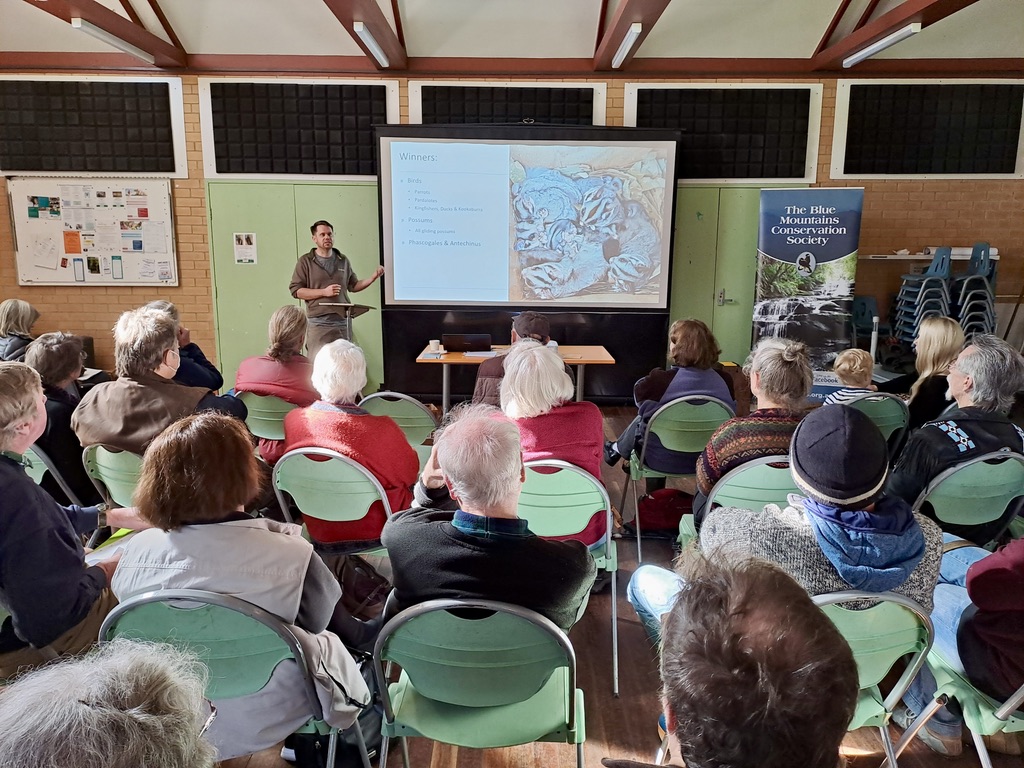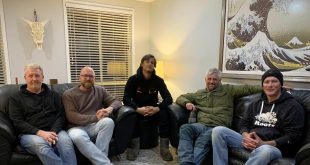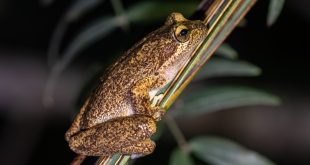
Habitat tree (Belle Butler)
Story by Belle Butler
Earlier this year the Blue Mountains Conservation Society held a workshop with Peter Ridgeway in Lawson to address the diminishing supply of hollows for wildlife and what we can do about it. Historical and ongoing loss of old trees due to clearing, arboriculture works, and bushfires is continuing to cause ongoing loss of habitat for much of our wildlife and threatening their ability to thrive.
Key Points:
- In Australia, over 300 species of native mammals and birds require hollows for shelter, roosting, and breeding.
- Clearing of native vegetation in NSW has continued at an estimated rate of over 30,000 ha per annum since 1995.
- Owing to the slow process of hollow development, and the particular value provided by large old trees, adverse effects from the continuing loss of old hollow-bearing trees will take centuries to fix.
Share this article:
Outside a kitchen window in Wentworth Falls two Crimson Rosellas found a hollow. It was small, only about 5 centimetres deep, because the host tree was relatively young. Each morning the birds would visit and try to expand the hollow and make it deeper to accommodate a nest for their young. Peter Ridgeway, who works in biodiversity restoration, was moved as he watched from his home. “They kept at it almost every day for nearly two months before finally giving up,” he said. He has since often wondered if they ever found a place to raise their chicks. “It brought home to me how in desperately short supply hollows are, and the impact this has on our wildlife.”
The word ‘hollow’ might suggest an emptiness. However, in the case of trees, it is anything but. Weathered and gnarled, bearing the wounds and scars of its years, an old tree is a sight to behold. Its traumas are character-building, telling stories of survival against the odds. Its traumas are also crucial for the survival of other creatures, who reside deep in the wounds of that mottled wood.
Hollows are the result of injury. While the external part of a tree may continue to grow, injuries allow the entry of fungi, bacteria and wood-chewing insects that cause decay or the hollowing out of the internal wood. They can take hundreds of years to form, so they only occur in very old or dead trees. Only certain tree species form hollows and only specific species of Eucalypts form appropriate hollows that accommodate the needs of particular wildlife.

Crimson Rosella using a natural hollow in Faulconbridge. (Peter Ridgeway)
In Australia, over 300 species of native mammals and birds require hollows for shelter, roosting, and breeding. Each animal has distinct requirements for their ideal accommodation, meaning the greater variety on offer, the better.
The problem is, hollows are in diminishing supply. Historical and ongoing loss of old trees due to clearing, arboriculture works, and bushfires causes ongoing loss of habitat for much of our wildlife.

Peter discussing the species of fauna that require hollows. (Belle Butler)
Andrew Solomon of the Blue Mountains Conservation Society explains: “Several factors have led to a sharp decline in the natural nesting infrastructure for many native species including the effect of the intense bushfires of the past decade, the continued clearing of native habitat, particularly close to urban areas, and the removal of trees, tree limbs and fallen timber from public and private property for firewood and other uses, or for safety concerns.”
Clearing of native vegetation in Australia varies depending on landscape. In NSW, it has continued at an estimated rate of over 30,000 ha per annum since 1995. A NSW State Government report on the loss of habitat trees states: “Owing to the slow process of hollow development, and the particular value provided by large old trees, adverse effects from the continuing loss of old hollow-bearing trees will take centuries to fix.”

Andrew Solomon of the Blue Mountains Conservation Society selling native plants and nest boxes. (Belle Butler)
To raise awareness and provide people with an opportunity to help, the Blue Mountains Conservation Society hosted a nest box event at the Mid Mountains Neighbourhood Centre in Lawson earlier this year. Ready-made nest boxes, crafted and donated by Oran Park Men’s Shed, were available to purchase.

\
Sugar Glider making a home of a nest box. (Peter Ridgeway)
The event was well attended, with audience at capacity and standing room only for any late comers. Peter was invited as a guest speaker. His presentation offered a broad sweep of background information as well as practical advice about the use of nest boxes as supplemental habitat for hollow-dwelling creatures. “Our local wildlife will never thrive unless we take action to increase the hollows available for them,” he said. “The shortage of hollows is a problem created by our modern lifestyles and decisions, but we also have the opportunity to be the solution.”
Audience member Robin Shannon attended the event to learn how to be a part of that solution. Having moved into a house in North Katoomba that backs onto swampland, he recognised how urban development in the area had degraded the ecosystem. “We have been looking for ways that we can repay some of this ecological debt,” he said. “There is still quite a lot of vertebrate life surviving on and around our property. However, as the street continues to urbanise and more and more old trees are cut down and more cats and dogs move in, these creatures are under increasing pressure. We feel it is our responsibility to try and create refugia for the animals that remain.”

Robin Shannon leans against the wall in a packed room at the Mid Mountains Neighbourhood Centre.
“Despite what it might say on title deeds or mortgage certificates, the land is not ours. We are just tenants, and we must be good tenants who are respectful to all the other creatures who already call this patch of earth home.” – Robin
While nest boxes are a valuable addition to their natural counterpart, Peter acknowledged that they alone cannot address the vastness of the problem. “Hollow augmentation provides a tool to mitigate the historic losses,” he said. “Like all mitigation, it is frequently misused to justify repeating the mistakes of the past. It’s critical to remember why we have a problem.” He stressed the importance of understanding the limitations of nest boxes and warned against undervaluing natural hollows or accepting their continued destruction.

Peter discussing species that successfully use nest boxes
So, is it as simple as building or buying a nest box and whacking it on the side of a tree? Not quite. While nest boxes may successfully provide supplemental habitat for some creatures, there are some important factors to consider:
- Check whether a species actually needs support. Over-accommodating certain species (omnivorous brushtail possums, for example) can be devastating to other fauna and flora in the area. Kookaburra numbers are plummeting and are therefore a good species to target. All gliding possums and Rosellas are also good species to target.
- The size and shape of a nest box will differ for different species. For example, sugar gliders need larger nesting space to accommodate family groups. Large natural hollows take the longest to form and are therefore in particularly short supply.
- The size and shape of the entry hole will differ for different species. Importantly, the size of the entry hole should be no larger than the size of the head of the target species, which is critical to prevent predators from entering.
- The position of the entry hole will also differ for different species. For example, birds will fly onto the box and need a hole at the front near the top, while small gliders will need a hole that is down low and on the side of box, near the trunk of the tree.
- Position the nest box with adequate height off the ground and affix it to a tree with a spacer or flexible zig zag wiring so as not to damage the tree.

Example of accidental ring-barking from incorrect installation of a nest box
- Use appropriate material to achieve best insulation. The thicker the wood, the better. This might include Pressure Treated Pine (not chemically treated pine, which is toxic) or Marine Ply (not standard ply).
- Nest boxes don’t have to be consistently dry. Their main function is to provide warmth. A damp interior functions like compost, providing good thermal insulation.
- Nest boxes do not require a lid or perch and should not be lined (most creatures prefer to do their own interior decorating).
- Once you have considered your target species and provided them with an appropriate nesting box, it is important not to disturb them. Monitor from a distance or by using a fixed camera, otherwise they may abandon the box.

Blue Mountains Conservation Society sold native plants at the event
The Blue Mountains Conservation Society strongly encourages residents to understand the issue and to give appropriately constructed nest boxes a try. Additionally, they encourage residents to be mindful of habitat trees on their property and to request all levels of government “take action to prevent further loss or destruction of natural habitats on public and private land.”
Take Action:
- Request all levels of government “take action to prevent further loss or destruction of natural habitats on public and private land.”
- Protect existing trees and give nest boxes a try. Peter Ridgeway advises that there is a wealth of information online, but to be aware that the quality of advice varies. He recommends visiting these sites if you would like to build your own nest box:
www.lls.nsw.gov.au/__data/assets/pdf_file/0006/656610/GS-LLS-Wildlife-Nest-Box-10-2017-Accessible.pdf
Remember to use hardwood or thick (>12 mm) hardwood ply, and avoid purchasing ‘recycled’ hollows, as these are harvested from the wild where the existing wildlife needs these hollows as homes. - The Blue Mountains Conservation Society aims to “help conserve the natural environment of the Blue Mountains and to increase awareness of the natural environment in general.” You can find out more about the Society on their website – bluemountains.org.au You can become a member of the Blue Mountains Conservation Society here: BMCS Membership
Share this article:
This story has been produced as part of a Bioregional Collaboration for Planetary Health and is supported by the Disaster Risk Reduction Fund (DRRF). The DRRF is jointly funded by the Australian and New South Wales governments.




